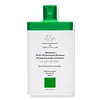What's inside
What's inside
 Key Ingredients
Key Ingredients

No key ingredients
 Benefits
Benefits

 Concerns
Concerns

 Ingredients Side-by-side
Ingredients Side-by-side

Water
Skin ConditioningSodium Cocoyl Isethionate
CleansingSodium Lauroyl Methyl Isethionate
CleansingSodium Lauroamphoacetate
CleansingGlycerin
HumectantCocamide Mipa
EmulsifyingCetyl Alcohol
EmollientPPG-3 Benzyl Ether Myristate
EmollientCaprylic/Capric Triglyceride
MaskingCoconut Acid
CleansingPolyester-37
Skin ConditioningSclerocarya Birrea Seed Oil
HumectantSilk Amino Acids
HumectantHydrolyzed Silk
HumectantSunflower Seed Oil Glycerides
EmollientSericin
Skin ConditioningDisunfloweroylethyl Dimonium Chloride
Lauryl Lactyl Lactate
Skin ConditioningTrisodium Ethylenediamine Disuccinate
Vanilla Planifolia Fruit Extract
Skin ConditioningCitric Acid
BufferingPolyquaternium-10
Polyquaternium-7
Acrylates/C10-30 Alkyl Acrylate Crosspolymer
Emulsion StabilisingCaprylyl Glycol
EmollientSodium Isethionate
CleansingSodium Benzoate
MaskingEthylhexylglycerin
Skin ConditioningHexylene Glycol
EmulsifyingPhenoxyethanol
PreservativePotassium Sorbate
PreservativeBenzyl Alcohol
PerfumingWater, Sodium Cocoyl Isethionate, Sodium Lauroyl Methyl Isethionate, Sodium Lauroamphoacetate, Glycerin, Cocamide Mipa, Cetyl Alcohol, PPG-3 Benzyl Ether Myristate, Caprylic/Capric Triglyceride, Coconut Acid, Polyester-37, Sclerocarya Birrea Seed Oil, Silk Amino Acids, Hydrolyzed Silk, Sunflower Seed Oil Glycerides, Sericin, Disunfloweroylethyl Dimonium Chloride, Lauryl Lactyl Lactate, Trisodium Ethylenediamine Disuccinate, Vanilla Planifolia Fruit Extract, Citric Acid, Polyquaternium-10, Polyquaternium-7, Acrylates/C10-30 Alkyl Acrylate Crosspolymer, Caprylyl Glycol, Sodium Isethionate, Sodium Benzoate, Ethylhexylglycerin, Hexylene Glycol, Phenoxyethanol, Potassium Sorbate, Benzyl Alcohol
Water
Skin ConditioningSodium Methyl Cocoyl Taurate
CleansingCocamidopropyl Hydroxysultaine
CleansingCocamidopropylamine Oxide
CleansingGlycerin
HumectantCocamidopropyl Betaine
CleansingGlyceryl Laurate
EmollientEpilobium Angustifolium Flower/Leaf/Stem Extract
Skin ConditioningSalix Alba Bark Extract
AstringentSodium Chloride
MaskingPanthenol
Skin ConditioningSalicylic Acid
MaskingMenthol
MaskingMelaleuca Alternifolia Leaf Oil
AntioxidantArctium Lappa Root Extract
Skin ConditioningChamomilla Recutita Flower Extract
MaskingArctostaphylos Uva-Ursi Leaf Extract
Skin ConditioningMelia Azadirachta Extract
Skin ConditioningVitex Trifolia Extract
Skin ConditioningBerberis Aquifolium Extract
Skin ConditioningZanthoxylum Zanthoxyloides Bark Extract
Skin ConditioningPhenoxyethanol
PreservativeEthylhexylglycerin
Skin ConditioningTocopheryl Acetate
AntioxidantAloe Barbadensis Leaf Juice
Skin ConditioningWater, Sodium Methyl Cocoyl Taurate, Cocamidopropyl Hydroxysultaine, Cocamidopropylamine Oxide, Glycerin, Cocamidopropyl Betaine, Glyceryl Laurate, Epilobium Angustifolium Flower/Leaf/Stem Extract, Salix Alba Bark Extract, Sodium Chloride, Panthenol, Salicylic Acid, Menthol, Melaleuca Alternifolia Leaf Oil, Arctium Lappa Root Extract, Chamomilla Recutita Flower Extract, Arctostaphylos Uva-Ursi Leaf Extract, Melia Azadirachta Extract, Vitex Trifolia Extract, Berberis Aquifolium Extract, Zanthoxylum Zanthoxyloides Bark Extract, Phenoxyethanol, Ethylhexylglycerin, Tocopheryl Acetate, Aloe Barbadensis Leaf Juice
Ingredients Explained
These ingredients are found in both products.
Ingredients higher up in an ingredient list are typically present in a larger amount.
Ethylhexylglycerin (we can't pronounce this either) is commonly used as a preservative and skin softener. It is derived from glyceryl.
You might see Ethylhexylglycerin often paired with other preservatives such as phenoxyethanol. Ethylhexylglycerin has been found to increase the effectiveness of these other preservatives.
Glycerin is already naturally found in your skin. It helps moisturize and protect your skin.
A study from 2016 found glycerin to be more effective as a humectant than AHAs and hyaluronic acid.
As a humectant, it helps the skin stay hydrated by pulling moisture to your skin. The low molecular weight of glycerin allows it to pull moisture into the deeper layers of your skin.
Hydrated skin improves your skin barrier; Your skin barrier helps protect against irritants and bacteria.
Glycerin has also been found to have antimicrobial and antiviral properties. Due to these properties, glycerin is often used in wound and burn treatments.
In cosmetics, glycerin is usually derived from plants such as soybean or palm. However, it can also be sourced from animals, such as tallow or animal fat.
This ingredient is organic, colorless, odorless, and non-toxic.
Glycerin is the name for this ingredient in American English. British English uses Glycerol/Glycerine.
Learn more about GlycerinPhenoxyethanol is a preservative that has germicide, antimicrobial, and aromatic properties. Studies show that phenoxyethanol can prevent microbial growth. By itself, it has a scent that is similar to that of a rose.
It's often used in formulations along with Caprylyl Glycol to preserve the shelf life of products.
Water. It's the most common cosmetic ingredient of all. You'll usually see it at the top of ingredient lists, meaning that it makes up the largest part of the product.
So why is it so popular? Water most often acts as a solvent - this means that it helps dissolve other ingredients into the formulation.
You'll also recognize water as that liquid we all need to stay alive. If you see this, drink a glass of water. Stay hydrated!
Learn more about Water